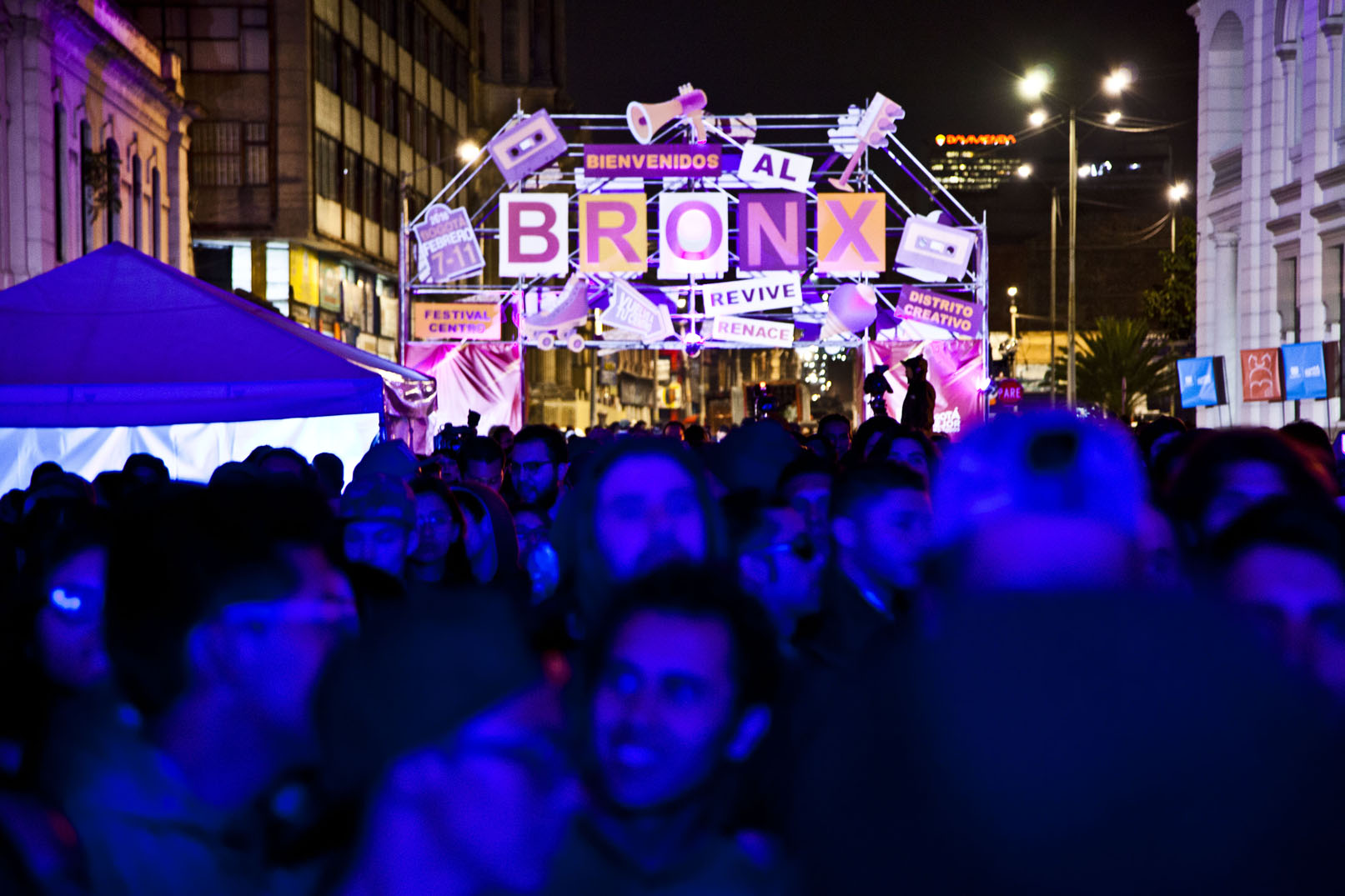 Cultural performance, Bogota - © Archivo Fotográfico Idartes
Cultural performance, Bogota - © Archivo Fotográfico Idartes Cultural performance in Bogota’ - © Archivo Fotográfico Secretaría de Cultura, Recreación y Deporte
Cultural performance in Bogota’ - © Archivo Fotográfico Secretaría de Cultura, Recreación y Deporte Cultural performance in Bogota’ - © Archivo Fotográfico Secretaría de Cultura, Recreación y Deporte
Cultural performance in Bogota’ - © Archivo Fotográfico Secretaría de Cultura, Recreación y Deporte Cultural performance in Bogota’ - © Archivo Fotográfico Secretaría de Cultura, Recreación y Deporte
Cultural performance in Bogota’ - © Archivo Fotográfico Secretaría de Cultura, Recreación y Deporte Cultural performance in Bogota’ - © Archivo Fotográfico Idartes
Cultural performance in Bogota’ - © Archivo Fotográfico Idartes Cultural performance in Bogota’ - © Archivo Fotográfico Secretaría de Cultura, Recreación y Deporte
Cultural performance in Bogota’ - © Archivo Fotográfico Secretaría de Cultura, Recreación y Deporte
Item 1 of 6
Status
ongoing
50%
City
Bogotá
Main actors
City Government
Project area
Whole City/Administrative Region
Duration
Ongoing since 2016
An innovative system mapping Bogota’s cultural and creative industries.
Bogota’s Culture Satellite Account (CSCB) is a project led by the Mayor's Office of Bogota and the DANE (Colombia's National Bureau of Statistics), that uses an international recognized methodology developed by the Andrés Bello Convention (an Iberoamerican organization that works towards an educational, scientific, technological and cultural integration) for measuring the economic impact of the city’s cultural and creative industries. This tool aims to identify, discuss and analyse how cultural products and activities are financed, who funds them, and who are the main beneficiaries.
City
Bogotá, Colombia
Size and population development
The city of Bogotá has a total population of 8,080,734, while its metropolitan area has a population of over 10,700,000. (world population review 2018)
Population composition
The 2005 census put the population density for the city at approximately 4,310 people per square kilometer. The rural area of the capital district only has about 15,810 inhabitants. The majority of the population is European or of European-mixed descent. The people of mixed descent are those of Mestizo origin. There is a small minority of Afro-Colombian and Indigenous people as well. The city has recorded significant growth for a number of years and is still growing at a rate of 2.65%, this is largely due to internal migration. Historically, Bogota’s main religion was Roman Catholic and the city is the seat of the Roman Catholic Archdiocese. In the most recent census, a large portion of the population declared they are non-practicing. (world population review 2018)
Main functions
Bogotá lies in central Colombia and is 2,640 metres about sea level in the Northern Andes Mountains. It is the capital and largest city of Colombia and the educational, cultural, commercial, administrative, financial, and political center. Bogotá is a territorial entity and has the same administrative status as the Departments of Colombia.
Main industries / business
Bogotá is the headquarters for all major commercial banks, and the Banco de la República, Colombia's central bank as well as Colombia's main stock market. As the capital city, it houses a number of government agencies including the national military headquarters and is the center of Colombia's telecommunications network. Additionally, most companies (domestic and international) in Colombia have their headquarters in Bogotá. Bogotá is a major center for the import and export of goods for Colombia and the Andean Community in Latin America and is the home of Colombia's tire, chemical, and pharmaceutical industries. Bogotá is the hub of air travel in the nation and the home of South America's first commercial airline Avianca (Aerovías Nacionales de Colombia). Railroads connect Bogotá with the Caribbean coast to the north and via (Puerto Beriro) with the Pacific coast to the west. Bogotá is on the Colombian section of the Pan-American and Simón Bolívar highways and has road connections with all major Colombian cities.
Sources for city budget
The City of Bogotá draws its budget for public expenditure largely from taxes, fees, fines, operating revenues.
Political structure
Bogotá, as the capital of the Republic of Colombia, houses the executive branch (Office of the President), the legislative branch (Congress of Colombia) and the judicial branch (Supreme Court of Justice, Constitutional Court, Council of State and the Superior Council of Judicature) of the Colombian government.
Administrative structure
The Mayor of Bogotá and the City Council, both elected by popular vote, are responsible for city administration. The City is divided into 20 localities and each of these is governed by an administrative board elected by popular vote, made up of no fewer than seven members. The Mayor designates local mayors from candidates nominated by the respective administrative board.
Website
http://www.bogota.gov.co/
Various public and private institutions in Bogota have been interested in obtaining specific data that analyzes the links between economic and cultural phenomena. However, public policy makers, trade unions, clusters and companies in the sector did not have access to official, continuous, comparable and reliable macroeconomic information that would allow them to examine the impact of culture and creativity pertaining to the development of the city. Therefore, the sector's opportunities and challenges in this sector were largely unknown.
The creation and implementation of the CSCB is outlined in the Local Development Plan, Bogota Mejor Para Todos 2016-2020. The key objective being "Better opportunities for development through culture, recreation and sport”. In 2017, in order to meet this objective, the Mayor's office of Bogota, through the Department of Culture, Recreation and Sport of Bogota (SDCRD), signed a 5 years agreement with the National Administrative Department of Statistics (DANE), (with the possibility of a 5-year extension).
The objectives of the CSCB are to provide:
- Publishing official information for the formulation of public policies, such as the District Public Policy of Cultural and Creative Economy;
- Indicators to measure both the quantitative and qualitative impacts of the cultural sector in Bogota.
- Realistic scenarios for the formulation of new projects that contemplate the context and the socioeconomic dynamics of key stakeholders;
- Facilitate strategic planning in cultural organizations from both the private and public sectors, with the objective of increasing productivity; and
- Providing reliable data in order to include within the public agenda the need to build mechanisms that strengthen the activities of the sector.
The implementation of the CSCB is divided into three phases:
1) Design
In the initial phase, it was necessary to develop working groups with public and private entities of the city in order to identify the most important sectors of the cultural and creative industries. These included both national and local public offices, and more than 20 different institutions from the private sector including universities, creative industries unions and non-profit organizations.
Using the different perspectives of these key stakeholders the SCRD team managed to prioritize the different cultural industries to be included in the CSCB. In 2017, the economic impact of the following cultural industries was first measured: music industry, theatre, publishing and audiovisual production. The following year four more sectors were added: cultural education, advertising, tangible heritage and intangible heritage. Finally, in the 2019, the visual arts, design, games and toys production, and creation with copyrights, were included in the CSCB.
The CSCB adapted to the city level the Andrés Bello Convention Methodological Guide which was initially designed for the national level. This implied modifying the methodology for the Colombian departments and using Bogota’s GDP according to DANE. Creating in this way, a “glocal” (global –local) perspective, to the extent that the data for Bogotá can be compared to that of other cities and even other countries.
2) Tracking and Consolidation of Information
During the stage of tracking and consolidating of existing information, the research team encountered a complex scenario, since, although the city has considerable economic data, some of the entities responsible for this data belong to the private sector, which makes access difficult. In this way, an extensive process involving a large number of private institutions was initiated, in order to obtain the relevant information. In this sense, the CSCB, besides being the means to obtain fundamental information for the sector, was presented as a platform to actively participate in the process of public policy formulation (especially in the District Public Policy of Cultural and Creative Economy), in projects and programs of the district government, and as an opportunity to make visible the work of the private institutions that were involved in the whole process. Thus, these entities were linked to the stages of the statistical operation, especially providing information from their administrative records, contextualization of the figures and analysis of their behavior over time, which gave legitimacy to the exercise.
3) Promotion and Outreach
The CSCB platform recognizes all its sources of information and makes visible information from multiple public and private entities, such as national administrative units, Bogota’s public offices, local mayors and associations, unions, collective management societies and inter-governmental bodies. In this way, it provides resources and sources of information so that the different stakeholders of the cultural sector may use them for their benefit. As a result, most of the entities that participated by providing information for the development of the calculations, make use of the data continuously and has used them in diverse scenarios, such as the Meeting of Cultural Capitals of the World (La Paz, Bolivia), Music Cities Summit (Toronto, Canada), Music Cities Convention (Melbourne, Australia), Ibero-American Forum of Cultural Diplomacy in Panama, Technical Table of Economic Indicators of Culture in Paris, International Film Festival of Cartagena (FICCI), Latin American Summit of Communication, Creativity, Innovation and Marketing (+CTG), Design Dialogues at Universidad El Bosque, Bogotá Design Festival, Bogotá Audiovisual Market and Bogotá Music Market, among others.
The lead agency for the project is the City of Bogota administered by the Mayor’s office and the Department of Culture, Recreation and Sport of Bogota (SDCRD). DANE, the National Bureau of Statistic, provides the statistical methodology and data.
The CSCB has established itself as a successful mechanism for capturing and presenting reliable, continuous and comparable data for the cultural and creative industries of Bogota. It allows creating synergies between the district's public policies and the actions of the different private entities that provide information, and at the same time it allows making decisions based on the results obtained year after year.
The first results of the CSCB were published at the end of 2017 on the DANE and SDCRD websites. The segments of books and publications, music, performing arts and audiovisual were included, and they were used for the publication Cuaderno 38 de Desarrollo Económico: Información económica de las industrias creativas y culturales en Bogota (Cuaderno 38 of Economic Development: Economic Information of the Creative and Cultural Industries in Bogota) of the District Secretariat of Economic Development.
The second publication of the CSCB took place in 2018, which included the segments of cultural education, advertising creation, tangible heritage and intangible heritage, and updated the series of previous segments. These new segments were included as part of the content of the book Caracterización de Industrias Culturales y Creativas en Bogota (Bogota’s Cultural and Creative Industries Characterization) published by Bogota Mayor's Office and the Bogota Chamber of Commerce, which also includes data for the music industry, performing arts, audiovisual, publishing industry, visual arts and non-profit sectors of the
In the second half of 2019, the updated results of the eight segments measured will be presented, and will include creation with copyrights, visual arts, games and toys production, and design.
Inter-institutional coordination achievements
- Efficient use of resources and coordination of statistics at local and national levels.
- Creating a research tool that provides an academic agenda focused on the cultural sector, with a specialized measurement methodology for Bogota, which is also internationally comparable.
Knowledge management achievements
- The CSCB includes specialized indicators to measure quantitative and qualitative impacts of the creative and cultural industries and identifies new sources of information for the measurements.
- The data shows the behavior and dynamics of cultural and creative activities.
- The CSCB allows the dimensioning of the creative and cultural industries and offers possibilities of comparison. It allows the availability of new, reliable and continuous information, and the measurement of the segments of the cultural sector.
- Provides information for investments decisions in both the public and private organizations of the cultural sector.
Decision-making achievements
- It is positioned as a core information system, fundamental for the formulation of cultural public policies. For example, the District Public Policy on Cultural and Creative Economy used the CSCB data as part of its argument and evidence of the economic conditions of the cultural and creative sector. The CSCB specifically shows the added value generated by different cultural activities and the generation of full-time jobs, as well as non-monetary indicators.
- The research and cultural findings on the city make it possible to identify better strategies for attracting foreign investment for the cultural sector in Bogotá.
Recognition of the cultural sector
- Recognizes and promotes the sector as a potential focus of economic development, including the profits generated by the different activities of each of its sub-sectors.
- It shows the arts and heritage as productive activities, which gives relevance to areas of the cultural sector that were not previously considered as generators of wealth.
Maintain the participation of all key stakeholders to guarantee its sustainability.
- The information should aim to generate knowledge, beyond macroeconomic aggregates. In this sense, it is important to determine what information is available and to identify opportunities for new studies that uses the CSCB data.
- It is crucial to disaggregate the raw information to obtain specific analyses of the different activities measured by the CSCB.
- Technological advances have a transversal impact on all segments of the cultural field, therefore it is important to consider the possibility of adapting the CSCB’s measurement methodology to include cultural production in the digital environment.
- The recording and management of data must be standardized, with the objective of making them comparable with other cities in Colombia and the world, this allows greater access to information from private organizations.
- Promoting the CSCB to the different key stakeholders in the cultural field, in order to increase their active participation.
- It is important to simplify the technical language of the CSCB, to broaden its use and promote a sense of ownership by the key stakeholders of the cultural sector.
- In order to make the CSCB visible as a planning tool, it is necessary to carry out a critical analysis of its raw information, this can be achieved by integrating qualitative research and promoting a crosspollination of data by different public and private institutions.
- In order to have optimal information (continuous, reliable and comparable), it is necessary to strengthen communication channels between institutions. This can be done through agreements/partnerships/conventions (public-private) that go beyond the periods of government, avoiding the loss of continuity and quality of data.
Lessons learned
The success of the CSCB depends on its capacity to compare the economic value of the cultural sector with other productive sectors. For this it is essential to diversify the channels of dissemination and to have standard process to systematize the information.
Consequently, it is crucial to keep improving access to primary information through greater inter-institutional coordination. And to achieve this, it is necessary to maintain a relationship of trust between all the public and private organizations involved in the CSCB.
In order to make the information more relatable and, ultimately, useful, the CSCB had to adapt statistical methodologies design originally for national and international standards, with a special focus on the generation of value by each subsector. It is also necessary to prioritize cultural segments in order to understand their particularities, and to have a phased measurement schedule, in a staggered manner, with a standard system for the recollection of secondary information which has to be complemented with the qualitative perspective of the cultural sector.
It is necessary to maintain partnerships in the medium and long term, to guarantee the CSCB’s operation regardless of the changes in government. The city is also working towards a regulatory framework that allows an efficient exchange of information between the national and local level.
The language should be simple so that the information can be understood by all the culture sub-sectors, without losing the technical dimension of the exercise.
The scope of the research should be made clear, since it is of a macroeconomic nature, and in order to have a broad and detailed panorama of the sector, complementary studies are required to understand the behavior of the aggregates resulting from the CSCB. In this way, this tool allows and promotes further research for each of the different sub-sectors.
Transferability
In 2017, the CSCB team was invited by the Entidad de Gestión Colectiva de Derechos de los Productores Audiovisuales (Audiovisual Production Copyright Associations) to write an article on the Bogotá Culture Satellite Account, published in the specialized journal Panorama Audiovisual Iberoamericano-2017. This article presented the background, theoretical framework, methodological adaptation, specific objectives and the work schedule of the CSCB. In addition, the two main references of the CSCB are described in more detail: the methodology of the United Nations System of National Accounts (2008) and the Methodological Guide for the implementation of the Culture Satellite Accounts in Ibero-America of the Andrés Bello Convention (2015).
Innovative elements
- The glocal perspective (global-local) approach for the measurement of the value generated by the culture sector in a specific territory.
- The methodological adaptation based on the characteristics of the culture sector and the context of the city, but framed in international manuals, which makes the data in the CSCB it comparable at a global level.
- It is the first Satellite Account at city level in the world, which provides detailed understanding of the cultural and creative sub-sectors of Bogota.
Effective elements
- The CSCB provides a framework to think the macroeconomic statistics in an integral way with other investigations. This way it becomes an input for decision making and its legitimacy is granted by articulated efforts carried out by diverse sources of information.
- The model of inter-institutional articulation with private and public entities at the national and district levels.
- Efficient communication between the public and private sectors, with a clear method of articulation to access primary information from all key stakeholders.
Sustainable elements
- Creation a methodology for Bogota’s cultural sector economic impact, which is internationally comparable.
- The positioning of the information system as a fundamental axis for the formulation of public policies in the culture sector.
- The inter-institutional articulation, with current and potential public-private alliances, make the CSCB a viable and sustainable exercise.
Replicable elements
- The design of a specialized measurement methodology, with availability of new, reliable and continuous information.
- The visibility of the size, in economic terms, of the cultural and creative sector.
Creating an information system that serves as input for key stakeholders and decision makers, as well as reliable source for the formulation of public policies.
City of Bogota’ Best practice document on Culture Satellite Account
External links / documents
On Map
The Map will be displayed after accepting cookie policy